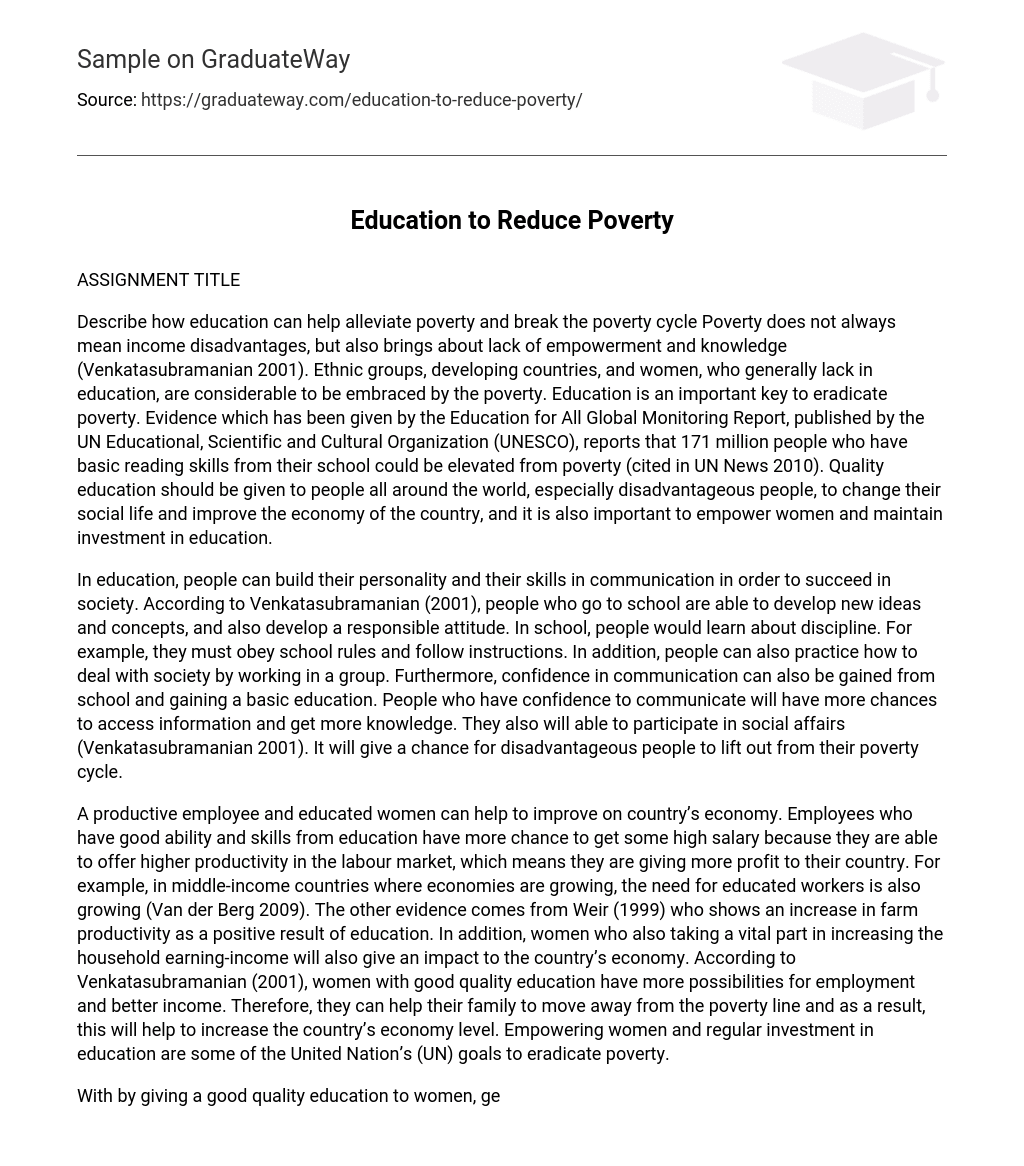ASSIGNMENT TITLE
Describe how education can help alleviate poverty and break the poverty cycle Poverty does not always mean income disadvantages, but also brings about lack of empowerment and knowledge (Venkatasubramanian 2001). Ethnic groups, developing countries, and women, who generally lack in education, are considerable to be embraced by the poverty. Education is an important key to eradicate poverty. Evidence which has been given by the Education for All Global Monitoring Report, published by the UN Educational, Scientific and Cultural Organization (UNESCO), reports that 171 million people who have basic reading skills from their school could be elevated from poverty (cited in UN News 2010). Quality education should be given to people all around the world, especially disadvantageous people, to change their social life and improve the economy of the country, and it is also important to empower women and maintain investment in education.
In education, people can build their personality and their skills in communication in order to succeed in society. According to Venkatasubramanian (2001), people who go to school are able to develop new ideas and concepts, and also develop a responsible attitude. In school, people would learn about discipline. For example, they must obey school rules and follow instructions. In addition, people can also practice how to deal with society by working in a group. Furthermore, confidence in communication can also be gained from school and gaining a basic education. People who have confidence to communicate will have more chances to access information and get more knowledge. They also will able to participate in social affairs (Venkatasubramanian 2001). It will give a chance for disadvantageous people to lift out from their poverty cycle.
A productive employee and educated women can help to improve on country’s economy. Employees who have good ability and skills from education have more chance to get some high salary because they are able to offer higher productivity in the labour market, which means they are giving more profit to their country. For example, in middle-income countries where economies are growing, the need for educated workers is also growing (Van der Berg 2009). The other evidence comes from Weir (1999) who shows an increase in farm productivity as a positive result of education. In addition, women who also taking a vital part in increasing the household earning-income will also give an impact to the country’s economy. According to Venkatasubramanian (2001), women with good quality education have more possibilities for employment and better income. Therefore, they can help their family to move away from the poverty line and as a result, this will help to increase the country’s economy level. Empowering women and regular investment in education are some of the United Nation’s (UN) goals to eradicate poverty.
With by giving a good quality education to women, gender disparity can be eliminated and this also has a strong effect on children’s health. For example, in Africa, many children who have a mother without any education die before reached five years old (Venkatasubramanian 2001). Mothers with good education might also increase the quality of education for their children for the next generation, this reason might help to break the cycle of the poverty. To reach all of the UN’s goals, regular investment to support education is needed. Irina Bokova states in UN News (2010) that to attain objectives successfully, the support for education needs to be sustainable and mobilized all around the world. For instance, by providing qualified teachers for poor areas from the local government (Singh, cited in UN News 2010). The continuity of investment in education will help solves poverty issues.
It is clear that world facing a serious problem which is poverty. It can be assumed that education can be a best solution to alleviate poverty. By giving an education to disadvantageous people, there are hopes to make a better life for them and to develop a better economy of their country. Moreover, it is important to give an education to women as they are a person who will raise their children, and also it would be good if the investment in education continually happen. Reference List
United Nations 2010, ‘Investing in Education will help advance global anti-poverty targets’ UN News, viewed 18/9/2013, http://www.un.org/apps/news/story.asp?NewsID=36081 van der Berg, S. 2009, ‘Education Reduces Poverty in Rich and Poor Countries’ International Academy of Education, viewed 18/9/2013, www.iiep.unesco.org/fileadmin/user_upload/Info…/EdPol10.pdf van der Berg, S. 2009, ‘Advantages of education in Poor Countries’ viewed 18/9/2013 http://www.iiep.unesco.org/fileadmin/user_upload/Info_Services_Publications/pdf/2009/EdPol10.pdf Venkatasaubramanian, K. (n.d.) ‘Education and Poverty’ The Hindu, viewed 18/9/2013, http://www.hindu.com/thehindu/op/2001/12/04/stories/2001120400060100.htm Weir, S 1999, ‘The effects of education on farmer productivity in rural Ethiopia’, Department of Economics, University of Oxford, viewed 18/9/2013, http://www.csae.ox.ac.uk/workingpapers/pdfs/9907text.PDF





